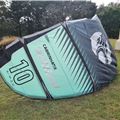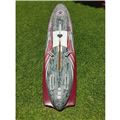1:58 AM Thu 25 Aug 2011 GMT
When your heart monitor tells you that you've gone over 100% of your maximum heart rate, something is wrong.
Three times during a race this happened to Sean Clarkson while racing the Artemis AC45 in Cascais, Portugal in the first round of the America's Cup World Series. Fortunately Clarkson was still breathing at the end of the race, but there's no doubt he and his fellow AC45 team mates are working to the limits - and beyond - of their fitness.
The man monitoring the team's fitness is British sports physiologist Pete Cunningham. After almost 20 years working with the Great Britain's top Olympic athletes in cycling, rowing, sailing and other sports, Cunningham went full-time with Artemis earlier this year.
When Sean Clarkson's heart rate hit 103% during racing, what exactly was going on? 'It suggests we read his max heart rate wrong,' says Cunningham, who puts all his athletes through a gruelling aerobic workout called a VO2 max test.
'Sean's heart rate is based on getting him to work as hard as possible in lab conditions. We did a rowing machine test, because sailing these boats is an all-body activity. The max heart rate is only two or three beats out, but it shows how hard it is at times sailing these boats, particularly if you do a few big grinds on the winches without much rest.'
Having worked with peak Olympic athletes such as the three-time Olympic Champion Ben Ainslie and double Olympic Champion Iain Percy (who is also a member of Artemis), Cunningham has got a good gauge of the fitness of top sailors.
For all except the helmsman, Cunningham's tests suggest that the fitness levels required for crewing an AC45 are on a par with anything he's seen in Olympic sailing.
'It's hard to make a direct comparison, but AC45 sailing is about a lot of explosive bursts in pretty short succession. If you tend to mess up a manoeuvre and fall back into the pack, it gets much much harder. There was one fleet race [in Cascais] where we had three gybes in short succession, and when the gybes don't go that well, it's really tough on the guys.'
A day's racing is all the exercise the sailors need, just a warm-up, cool-down and stretch routine to keep the muscles from seizing up. On non-race days, the sailors will be in the gym pushing and pulling weights to build up their base strength. To replicate the 'on-off' nature of the fitness required during a race day, Cunningham has all the sailors on a regime of interval training. Whether it's running, rowing or boxing, it doesn't matter - but the key is to work really hard for short bursts in between short recovery breaks before picking up the pace again.
Calorie consumption is high, around 2,500 calories burned during a typical session of racing, and the sailors are struggling to maintain weight. In other words the more they can eat and drink, the better.
by Andy Rice
|







